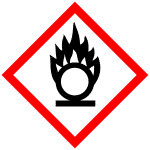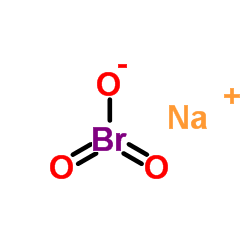CHEMICAL IDENTIFICATION
-
RTECS NUMBER :
-
EF8750000
-
CHEMICAL NAME :
-
Bromic acid, sodium salt
-
CAS REGISTRY NUMBER :
-
7789-38-0
-
LAST UPDATED :
-
199712
-
DATA ITEMS CITED :
-
8
-
MOLECULAR FORMULA :
-
Br-O3.Na
-
MOLECULAR WEIGHT :
-
150.90
-
WISWESSER LINE NOTATION :
-
NA E-O3
HEALTH HAZARD DATA
ACUTE TOXICITY DATA
-
TYPE OF TEST :
-
LD50 - Lethal dose, 50 percent kill
-
ROUTE OF EXPOSURE :
-
Intraperitoneal
-
SPECIES OBSERVED :
-
Rodent - mouse
-
DOSE/DURATION :
-
140 mg/kg
-
TOXIC EFFECTS :
-
Details of toxic effects not reported other than lethal dose value
-
REFERENCE :
-
COREAF Comptes Rendus Hebdomadaires des Seances, Academie des Sciences. (Paris, France) V.1-261, 1835-1965. For publisher information, see CRASEV. Volume(issue)/page/year: 257,791,1963
-
TYPE OF TEST :
-
LDLo - Lowest published lethal dose
-
ROUTE OF EXPOSURE :
-
Subcutaneous
-
SPECIES OBSERVED :
-
Mammal - dog
-
DOSE/DURATION :
-
120 mg/kg
-
TOXIC EFFECTS :
-
Behavioral - muscle weakness Lungs, Thorax, or Respiration - respiratory depression Blood - other changes
-
REFERENCE :
-
SAPHAO Skandinavisches Archiv fuer Physiologie. (Stockholm, Sweden) V.1-83, 1899-1940. For publisher information, see APSCAX. Volume(issue)/page/year: 30,337,1913
-
TYPE OF TEST :
-
LDLo - Lowest published lethal dose
-
ROUTE OF EXPOSURE :
-
Oral
-
SPECIES OBSERVED :
-
Rodent - rabbit
-
DOSE/DURATION :
-
250 mg/kg
-
TOXIC EFFECTS :
-
Behavioral - somnolence (general depressed activity) Gastrointestinal - hypermotility, diarrhea Blood - other changes
-
REFERENCE :
-
SAPHAO Skandinavisches Archiv fuer Physiologie. (Stockholm, Sweden) V.1-83, 1899-1940. For publisher information, see APSCAX. Volume(issue)/page/year: 30,337,1913
-
TYPE OF TEST :
-
LDLo - Lowest published lethal dose
-
ROUTE OF EXPOSURE :
-
Intravenous
-
SPECIES OBSERVED :
-
Rodent - rabbit
-
DOSE/DURATION :
-
360 mg/kg
-
TOXIC EFFECTS :
-
Lungs, Thorax, or Respiration - dyspnea Gastrointestinal - hypermotility, diarrhea Blood - other changes
-
REFERENCE :
-
SAPHAO Skandinavisches Archiv fuer Physiologie. (Stockholm, Sweden) V.1-83, 1899-1940. For publisher information, see APSCAX. Volume(issue)/page/year: 30,337,1913
-
TYPE OF TEST :
-
LDLo - Lowest published lethal dose
-
ROUTE OF EXPOSURE :
-
Subcutaneous
-
SPECIES OBSERVED :
-
Rodent - guinea pig
-
DOSE/DURATION :
-
100 mg/kg
-
TOXIC EFFECTS :
-
Lungs, Thorax, or Respiration - respiratory depression Kidney, Ureter, Bladder - hematuria Blood - other changes
-
REFERENCE :
-
SAPHAO Skandinavisches Archiv fuer Physiologie. (Stockholm, Sweden) V.1-83, 1899-1940. For publisher information, see APSCAX. Volume(issue)/page/year: 30,337,1913 *** NIOSH STANDARDS DEVELOPMENT AND SURVEILLANCE DATA *** NIOSH OCCUPATIONAL EXPOSURE SURVEY DATA : NOES - National Occupational Exposure Survey (1983) NOES Hazard Code - X4132 No. of Facilities: 2680 (estimated) No. of Industries: 5 No. of Occupations: 9 No. of Employees: 27921 (estimated) No. of Female Employees: 18633 (estimated)
|




